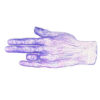Liger, Untitled, Belgian Blue (2012)
Screen Print – 22″ x 30″
on 250gsm Stonehenge Archival Paper
Screen Print
Limited Edition of 30
Gender, whether male or female, is an issue that effects not just those pushing its boundaries, but also those that like to keep those boundaries clearly defined.
Take for example Canada’s passport laws regarding gender, transgendered Miss Universe Canada contestant Jenna Talackova’s fight to compete, or the ongoing struggle for marriage equality in the United States. Gender is at the core of all these issues, or more specifically, the legal and/or social rights associated with one’s gender.
For those who hold ‘traditional’ family values, men are defined by their ability to provide. They’re should be tough, muscular and assertive. Whereas women should take on the role of either sex object or caregiver; nurturing, gentle and passive. While there is nothing wrong with the these traits on their own, assigning them to specific genders creates oversimplified stereotypes. Media helps to reinforce these stereotypes with television shows like Keeping Up with the Kardashians, UFC, and the some 3,000 advertising messages we see daily. Within these narrow perimeters where do androgynous, gender fluid or transgendered people fit? 33.2% of transgender youth have attempted suicide.(1) 74% of transgender youth reported being sexually harassed at school, and 90% of transgender youth reported feeling unsafe at school because of their gender expression.(2) In a survey of 403 transgender people, 78% reported having been verbally harassed and 48% reported having been victims of assault, including assault with a weapon, sexual assault or rape.(3)
These disturbing realities are the result of the conflict between our own gender identity and what society teaches us are appropriate way to express that outwardly through our appearance, mannerisms and interactions with others. This conflict doesn’t just affect the transgendered community, more and more how people define their gender is differing from what they look like physically.
We live in a world where the ability to make changes to our physical appearance is more accessible. Analysts at Goldman Sachs estimate that the global beauty industry (consisting of skin care, makeup, hair-care products and perfumes) worth a total of $95 billion is growing at up to 7% a year, more than twice the rate of the developed world’s GDP. $34-50 billion is spent every year on cosmetic surgery procedures, with over $2.3 billion spent on liposuction and breast augmentation in the US alone.
Whether big business or societal pressure, it all comes down to transcribing certain physical parameters onto our bodies. But does having muscles make you less of a woman, or does being nurturing make you less of a man? What about having a penis, does having a penis make you a man? Our historical and cultural definitions of gender do have influence, but those influences shouldn’t define us. No matter your gender, it’s your body: society and the law have no place dictating or defining what it should look like, what you can do with it, or whom you can love.
1-Clements-Nolle K., Marx R., Katz M. (2006). Attempted suicide among transgender persons: The influence of gender-based discrimination and victimization. Journal of Homosexuality, 51(3): 53-69.)
2-(GLSEN. (2001). The 2001 national school climate survey: the school related experiences of our nation’s lesbian, gay, bisexual and transgender youth.)
3-(Wilchins, R., Lombardi, E., Priesing, D. and Malouf, D. (1997) First national survey of transgender violence. Gender Public Advocacy Coalition.)









